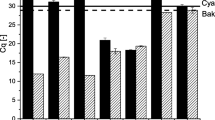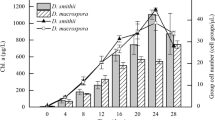Abstract
To compare oxidative dissolution rates of chalcopyrite by different consortia of moderately thermophilic acidophiles, various defined mixed cultures of three bacteria Acidithiobacillus caldus s2, Leptospirillum ferriphilum YSK, and Sulfobacillus sp. LN and one archaeon Ferroplasma thermophilum L1 were studied in batch shake flask cultures incubated at 45 °C. Chalcopyrite dissolution was determined by measuring variations of soluble copper, ferric iron, and pH. Microbial population dynamics involved in bioleaching process were monitored using real-time quantitative polymerase chain reaction (PCR) technology. The complex consortia containing both chemoautotrophic (L. ferriphilum and At. caldus) and chemomixotrophic (Sulfobacillus LN and F. thermophilum) moderate thermophiles were found to be the most efficient in all of those tested. Mutualistic interactions between physiologically distinct moderately thermophilic acidophiles, involving transformations of iron and sulfur and transfer of organic compound, were considered to play a critical role in promoting chalcopyrite dissolution. The real-time PCR assay was reliable to analyze population dynamics of moderate thermophiles in bioleaching systems, and the analysis results were consistent with physiological characteristics of these strains.




Similar content being viewed by others
References
Battaglia-Brunet F, Clarens M, d’Hugues P, Godon JJ, Foucher S, Morin D (2002) Monitoring of a pyrite-oxidising bacterial population using DNA single-strand conformation polymorphism and microscopic techniques. Appl Microbiol Biotechnol 60:206–211
Demergasso CS, Galleguillos PA, Escudero LV, Zepeda VJ, Castillo D, Casamayor EO (2005) Molecular characterization of microbial populations in a low-grade copper ore bioleaching test heap. Hydrometallurgy 80:241–253
Dew DW, Van Buuren C, McEwan K, Bowker C (2000) Bioleaching of base metal sulphide concentrates: a comparison of high and low temperature bioleaching. J S Afr I Min Metall 100:409–413
Diaby N, Dold B, Pfeifer HR, Holliger C, Johnson DB, Hallberg KB (2007) Microbial communities in a porphyry copper tailings impoundment and their impact on the geochemical dynamics of the mine waste. Environ Microbiol 9:298–307
Dopson M, Lindström EB (1999) Potential role of Thiobacillus caldus in arsenopyrite bioleaching. Appl Environ Microb 65:36–40
Dopson M, Baker-Austin C, Hind A, Bowman JP, Bond PL (2004) Characterization of Ferroplasma isolates and Ferroplasma acidarmanus sp. Nov., extreme acidophiles from acid mine drainage and industrial bioleaching environments. Appl Environ Microb 70:2079–2088
Gao J, **e J, Ding J, Kang J, Cheng H, Qiu G (2006) Extraction and purification of magnetic nanoparticles from strain of Leptospirillum ferriphilum. T Nonferr Metal Soc 16:1417–1420
Goebel BM, Stackebrandt E (1994) Cultural and phylogenetic analysis of mixed microbial populations found in natural and commercial bioleaching environments. Appl Environ Microb 60:1614–1621
Golyshina OV, Pivovarova TA, Karavaiko GL, Kondrat’eva TF, Moore ERB, Abraham WR, Lunsdorf H, Timmis KN, Yakimov MM, Golyshin PN (2000) Ferroplasma acidiphilum gen. nov., sp. nov., an acidophilic autotrophic, ferrous-iron-oxidizing, cell-wall-lacking, mesophilic member of the Ferroplasmaceae fam. Nov., comprising a distinct lineage of the Archaea. Int J Syst Evol Micr 50:997–1006
González-Toril E, Llobet-Brossa E, Casamayor EO, Amann R, Amils R (2003) Microbial ecology of extreme acidic environment, the Tinto River. Appl Environ Microb 69:4853–4865
Hallberg KB, Johnson DB (2001) Biodiversity of acidophilic prokaryotes. Adv Appl Microbiol 49:37–84
Hawkes RB, Franzmann PD, O’hara G, Plumb JJ (2006) Ferroplasma cupricumulans sp. nov., a novel moderately thermophilic, acidophilic archaea isolated from an industrial-scale chalcocite bioleach heap. Extremophiles 10:525–530
Johnson DB (1998) Biodiversity and ecology of acidophilic microorganisms. FEMS Microbiol Ecol 27:307–317
Liu C, Plumb J, Hendry P (2006) Rapid specific detection and quantification of bacteria and archaea involved in mineral sulfide bioleaching using real-time PCR. Biotechnol Bioeng 94:330–336
Norris PR, Burton NP, Foulis NAM (2000) Acidophiles in bioreactor mineral processing. Extremophiles 4:71–76
Okibe N, Gericke M, Hallberg KB, Johnson DB (2003) Enumeration and characterization of acidophilic microorganisms isolated from a pilot plant stirred-tank bioleaching operation. Appl Environ Microb 69:1936–1943
Okibe N, Johnson DB (2004) Biooxidation of pyrite by defined mixed culture of moderately thermophilic acidophiles in pH-controlled bioreactor: significance of microbial interaction. Biotechnol Bioeng 87:574–583
Olson GJ, Brierley JA, Brierley CL (2003) Bioleaching review part B: Progress in bioleaching: application of microbial processes by the minerals industries. Appl Microbiol Biotechnol 63:249–257
Plumb JJ, Gibbs B, Stott MB, Robertson WJ, Gibson JAE, Nichols PD, Watling HR, Franzmann PD (2002) Enrichment and characterisation of thermophilic acidophiles for the bioleaching of mineral sulphides. Miner Eng 15:787–794
Qiu G, Fu B, Zhou H, Liu X, Gao J, Liu F, Chen X (2007) Isolation of a strain of Acidithiobacillus caldus and its role in bioleaching of chalcopyrite. World J Microbiol Biotechnol 23:1217–1225
Rawlings DE, Johnson DB (2007) The microbiology of biomining: development and optimization of mineral-oxidizing microbial consortia. Microbiology 153:315–324
Rawlings DE, Tributsch H, Hansford GS (1999) Reasons why ‘Leptospirillum’-like species rather than Thiobacillus ferrooxidans are the dominant iron-oxidizing bacteria in many commercial processes for the biooxidation of pyrite and related ores. Microbiology 145:5–13
Rohwerder T, Gehrke T, Kinzler K, Sand W (2003) Bioleaching review part A: Progress in bioleaching: fundamentals and mechanisms of bacterial metal sulfide oxidation. Appl Microbiol Biotechnol 63:239–248
Sand W, Gehrke T, Jozsa PG, Schippers A (2001) (Bio)chemistry of bacterial leaching—direct vs. indirect bioleaching. Hydrometallurgy 59:159–175
Stott MB, Watling HR, Franzmann PD, Sutton D (2000) The role of iron-hydroxy precipitates in the passivation of chalcopyrite during bioleaching. Miner Eng 13:1117–1127
Watling HR (2006) The bioleaching of sulphide minerals with emphasis on copper sulphides—a review. Hydrometallurgy 84:81–108
Zhou H, Zhang R, Hu P, Zeng W, **e Y, Wu C, Qiu G (2008) Isolation and characterization of Ferroplasma thermophilum sp. nov., a novel extremely acidophilic, moderately thermophilic archaeon and its role in bioleaching of chalcopyrite. J Appl Microbiol 105:591–601
Acknowledgements
This research was supported by the National Nature Science Foundation of China (no. 50621063), the National Basic Research Program of China (“973” Program, 2004CB619204), the China Ocean Mineral Resources Research and Development Association (no. DYXM-115-02-2-07), and the State Oceanic Administration of People’s Republic of China (no. 200805032).
Author information
Authors and Affiliations
Corresponding author
Rights and permissions
About this article
Cite this article
Zhang, Rb., Wei, Mm., Ji, Hg. et al. Application of real-time PCR to monitor population dynamics of defined mixed cultures of moderate thermophiles involved in bioleaching of chalcopyrite. Appl Microbiol Biotechnol 81, 1161–1168 (2009). https://doi.org/10.1007/s00253-008-1792-8
Received:
Revised:
Accepted:
Published:
Issue Date:
DOI: https://doi.org/10.1007/s00253-008-1792-8




